The Sophisticated Water Technologies of the Ancient Nabataeans
The Nabataeans were an ancient Semitic people, dating back to 586 BC, who inhabited northern Arabia and the southern Levant. The desert climate created agricultural difficulties for the Nabataeans, but they rose to the challenge, creating a sophisticated water collection system which allowed them to build an impressive trade empire in the heart of Arabia.
The first records of the Nabataeans show that they were nomadic peoples who lived in Edomite territory, although there is some dispute as to how and when the Nabataeans arrived there. Some believe that they lived alongside the Edomites for hundreds of years, while others maintain that the Nabataeans migrated to the Edomite territory after the Edomites moved north.
- Petra, Jordan: Gorgeous Rose-Red City and Wonder of the World
- Mada'in Saleh - Saudi Arabia’s Abandoned Nabatean City
At one point they had political control over an area reaching from Yemen to Damascus and western Iraq into the Sinai Desert. Highly secretive, Nabatean culture was however resistant to leaving any records, making it hard to decipher their history. Around the 4th century BC, the Nabataeans eventually chose the site of Petra to build their city, located in modern-day southern Jordan, and hidden away in a rock cleft.
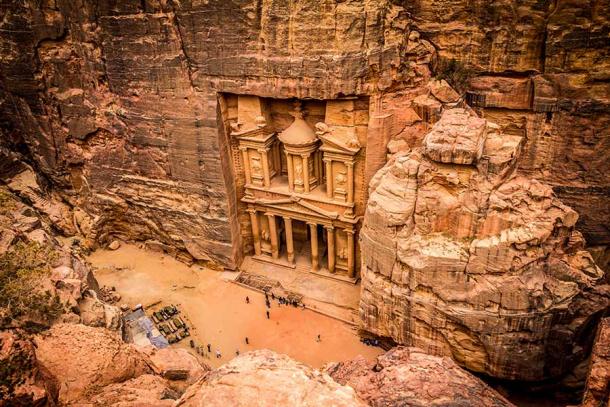
The spectacular ancient city of Petra was built by the Nabateans.(pcalapre / Adobe Stock)
The Nabateans, Petra and their Battle Against the Desert Climate
The biggest challenge for the Nabataeans was the dry, arid climate of the canyon in which Petra was located. This made agriculture challenging, as they had to work towards ways to ensure that there would be an adequate water supply for the inhabitants and to support whatever they planted.

Water reservoir above the Nabatean city of Petra in Jordan. (Nikolay / Adobe Stock)
One method for gathering water was to plant a single fruit tree in the middle of an area that had been contoured into a shallow funnel. When it rained, all water would flow down into the center of the funnel, and would be sealed in by the silt-sized sediment called loess, and the water would be preserved.
But the impressive water channeling technology created by the Nabateans included many other processes, including the construction of aqueducts, terraces, dams, cisterns, and reservoirs, as well as methods for harvesting rainwater, flood water, groundwater, and natural springs.
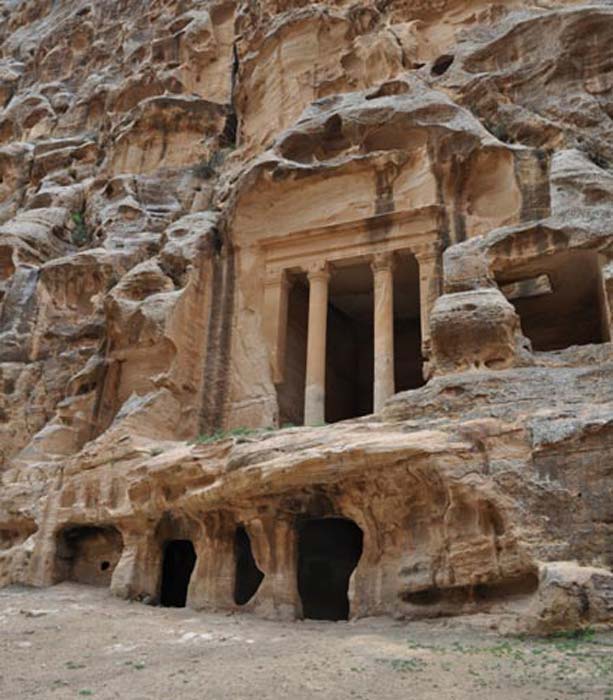
Cisterns at the Nabataean city of Little Petra. (Larry W. Mays)
Nabateans and their Water Technology
Using their sophisticated water technology, the Nabataeans were able to ensure a continuous water supply throughout the year. They had an intimate understanding of every possible source of water available to them, and of how to best monitor, harness, maintain, and utilize that water supply.
“For in the waterless region, as it is called, they have dug wells at convenient intervals and have kept the knowledge of them from people of all other nations, and so they retreat in a body into this region out of danger,” wrote the ancient Greek historian Diodorus of the Nabateans. “For since they themselves know about the places of hidden water and open them up, they have for their use drinking water in abundance.”
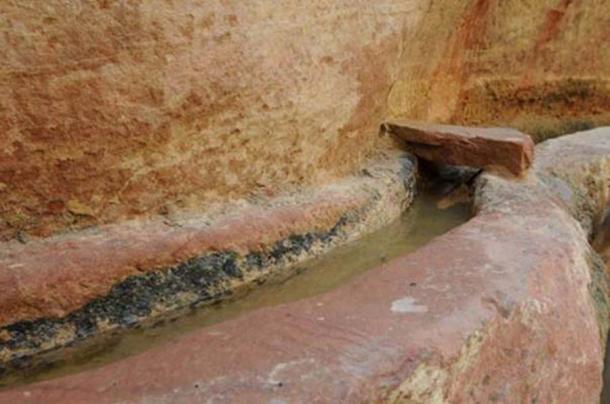
Aqueduct channel showing rock cover that once covered the aqueduct. (Larry W. Mays)
“They take refuge in the desert using this as a fortress; for it lacks water and cannot be crossed by others, but to them alone, since they have prepared subterranean reservoirs lined with stucco,” explained Diodorus. “After filling these reservoirs with rain water, they close the openings, making them even with the rest of the ground, and they leave signs that are known to themselves but are unrecognizable to others,” he continued.
They balanced their reservoir water storage capacity with their pipeline system, ensuring a constant water supply. The system design also utilized particle-settling basins to purify their potable water. The Nabataeans’ extensive understanding of hydraulics allowed them to create a system that maximized water flow rates while minimizing leakage. It is not surprising that this highly-advanced technology was used first to benefit the civil elite, eventually filtering down to the lower levels of society.
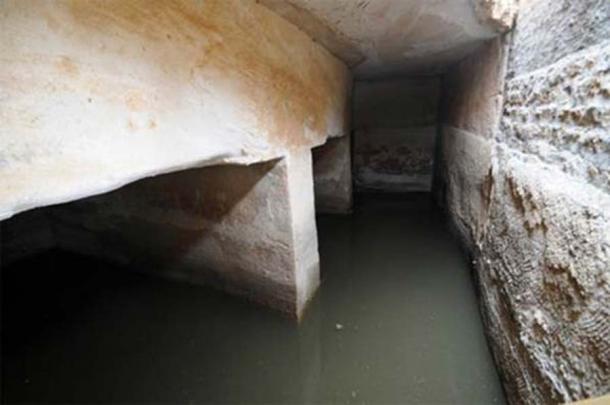
Inside large cistern at the Nabataean city of Little Petra. (Larry W. Mays)
The Top Secret Nature of the Nabatean Water Supply
The Nabateans created their water collection structures so that they would be invisible to passers-by, and so that they could only be found by those who knew of their presence. The complex systems collected water from mountains. They shaped rocks into ledges to collect the initial flow of water from the mountain. They chiseled channels into the sides of the mountain, trailing the water flow into cisterns and dams for later usage.
The Nabateans built stone walls and pillars to shade the water collection in the cisterns, keeping the water cool and preventing evaporation. They created underground cisterns that were lined with waterproof cement, to prevent the water from seeping into the earth. The cisterns were very well-constructed, and several of them are still in use to this day. All of these structures were created with the idea of secrecy in mind, so that few would realize the purpose and function of the structures. This protected the Nabatean water supply from invaders and strangers.
- Magnificent Gardens of Petra Discovered After 2,000 Years
- Ancient Monuments of the Nabataeans were Built According to Celestial Events
In ancient times, one of the most important factors that civilizations had to take into consideration was their supply of water. If they wanted to live any distance from a reliable source of potable water, they had to find other ways to collect water for agricultural and other purposes.
The Nabataeans are a prime example of a culture that was highly advanced for its time, as they had to understand hydraulics to create their impressive system of water collection. Through ingenious methods, they were able to create a water collection distribution system that allowed their people, their trading network, and the city of Petra to thrive for many, many years.
Top image: The Nabateans built this reservoir at the Nabataean city of ancient Hawara, modern Humayma or “Humeima”. Source: Larry W. Mays
By M R Reese
References
Corbett, G. J. 4 November 2021. “Solving the Enigma of Petra and the Nabataeans” in Bible History Daily. Available at: http://www.biblicalarchaeology.org/daily/ancient-cultures/ancient-near-eastern-world/solving-the-enigma-of-petra-and-the-nabataeans/
Dat, J. 7 November 2021. “Archaeologists stunned by ‘marvel of engineering’ found in lost civilization of Petra” in Express. Available at: https://www.express.co.uk/news/science/1516897/archaeology-news-stunned-marvel-engineering-lost-civilisation-petra-ancient-history-spt
Mays, L. W. 24 March 2014. “Ancient Water Technologies of the Nabataeans” in Ancient Water Technologies. Available at: http://lwmays.wordpress.com/2014/03/24/ancient-water-technologies-of-the-nabataeans/
No name. No date. “Who were the Nabataeans?” in Nabataean.net. Available at: https://nabataea.net/explore/history/who/
No name. No date. “Water collection” in Nabataean.net. Available at: http://www.nabataea.net/water.html
Ortloff, C. R. 2005. “The Water Supply and Distribution System of the Nabataean City of Petra (Jordan)” in Cambridge Archaeological Journal. Available at: http://www.bible.ca/archeology/bible-archeology-exodus-kadesh-barnea-petra-water-supply-of-petra-charles-r-ortloff-2005.htm
















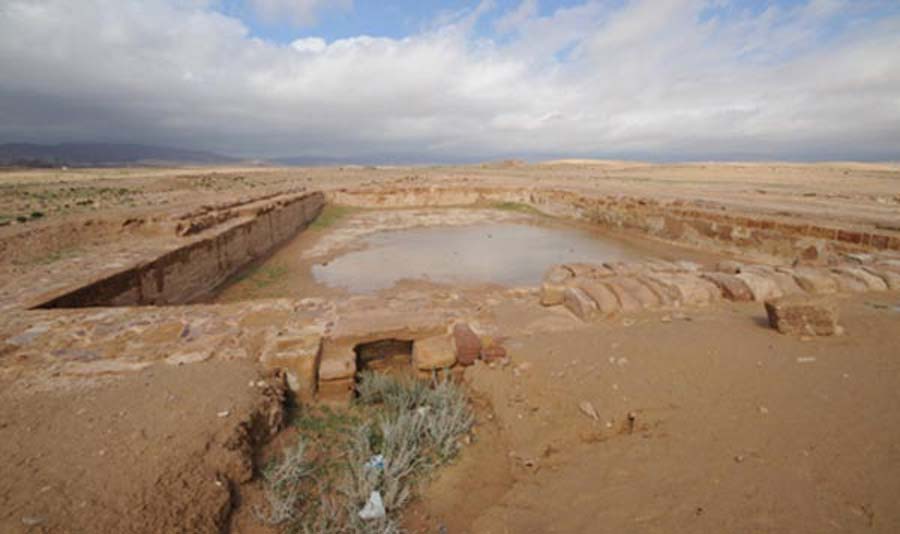

Comments
As is often the case with ancient or not-so-ancient sites, if you want to stroll around Petra without enduring the heat, dust, expense, and exhaustion just do a Google Streetview and add a bit of imagination.
From what I’ve seen, which of course is limited, there’s no evidence that any ancient Semitic peoples had a stone mason culture, or had cut, moved and erected megalith structures. But as stone is durable, the ancient ruins would exist through the ages, and thus where unoccupied, be resettled later by a migrant people likely unrelated to the long-gone aboriginal builders. The ancient texts support this idea, making no mention of quarrying, etc., but instead often mentioning making mud bricks. The BIG question is, what happened to the culture that built with huge stone blocks, and why are the structures themselves all found existing in a some degree of ruin? What and when was the calamity that caused the ruin and ended that culture?
Nobody gets paid to tell the truth.
How do we go from something so mysticly and gracefully sufficient to the way we are now? The whole world would be better if all architecture captured and utilized all natural form or water like that.
Peace and Love,
Ricky.